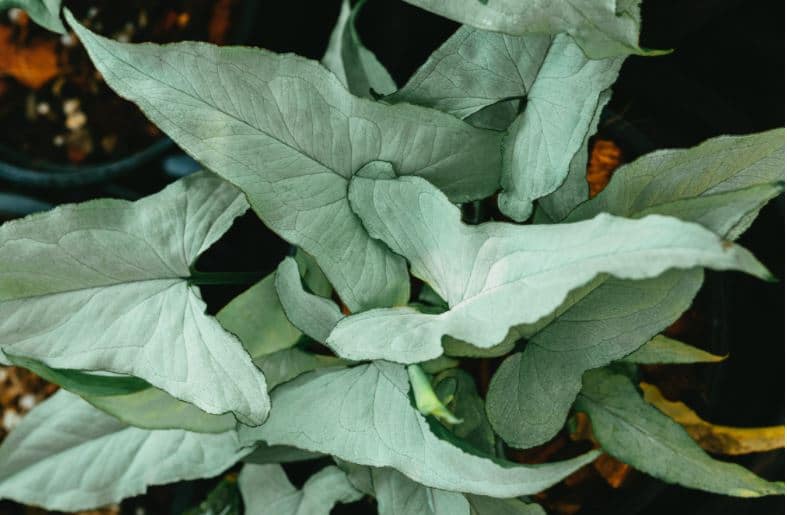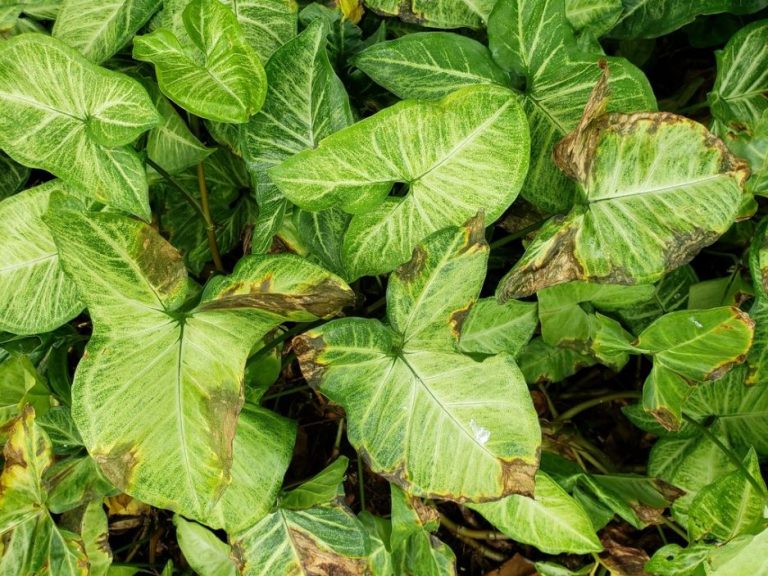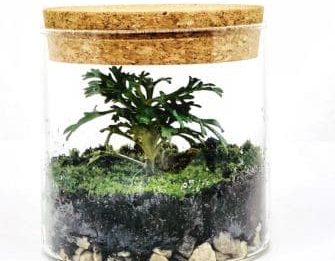
Arrowhead plant, that originates from countries including Mexico to Brazil and Bolivia have arrowheaded-shaped leaves at the juvenile stage that are glossy, leathery and brightly colored.
They usually grow in a tropical rainforest. It grows as a climbing epiphyte (any plant that grows upon another plant or object merely for physical support).
It is a Fast-growing vine. As the plant ages, you can either trail them from a hanging basket or trained up support using a moss pole. The aerial roots they develop will attach to the moss pole.
It can also be grown as a groundcover plant. Their leaves will get bigger when they grow tall.
This article will tell you everything you need to know about how to care for the Arrowhead plant.
This site contains affiliate links to products. We may receive a commission for purchases made through these links. The price you pay is exactly the same if you do or do not use my links. There are no extras costs to you.
How to care for arrowhead plant
Arrowhead plant is an easy to care plant. Let us delve into their cultural requirements.
Arrowhead plant low light
Arrowhead plants are adaptable to low light but, they prefer bright indirect light as they grow faster.
Give them bright indirect light, especially for variegated ones.
If you have low light, then go for greener varieties like Mini Allusion Syngonium ( not like Syngonium Glo-Go, which needs brighter light).
The Arrowhead plants grown indoors do not bloom.
Buy Syngonium ‘Strawberry’ – Arrowhead Plant on Amazon
How often to water arrowhead plant
Keep moist from spring to fall. In winter, apply only enough water to prevent the soil dry out.
Arrowhead plants are okay being slightly dry. Don’t dry them too much as it sheds a lot of leaves.
Water frequently if your plants get bright light and try to keep the soil moist. If you are in very low light, don’t water them a lot.
They get root rot when you keep it soggy so, do not overwater.
Arrowhead plant humidity
This plant likes humidity and thrives in humid spots as they come from the tropics. To maintain humidity:
- You can keep all humidity loving plants together
- Keep it in trays with pebble and water (pebble tray)
- Mist frequently if the plant is drying
- Go for a humidifier
Buy Variegated Arrowhead syngonium Podophyllum albo-variegatum (syngonium albo) Rare Plant on Amazon
Soil for Arrowhead plant
Arrowhead plant prefers acidic soil that retains moisture but not holds excess water. So, well-aerated and rich moisture retaining mix is great for this plant.
You can mix peat moss/cocopeat with garden soil, coarse sand, compost, bark, or perlite to make it a perfect combination.

Buy coloring book on Amazon:
Masterpieces of Coloring: For the Colorist Who Wants a Challenge Paperback
Arrowhead plant propagation
It is easy to propagate the Arrowhead plant. Propagation is best done during the plant’s active growth period, which is usually in the spring or summer. You can propagate the Arrowhead plant both in water and soil.
Arrowhead plants can be propagated through division, by stem cutting, and aerial roots from runner stem.
Arrowhead plant propagation in water
- Every leaf has a node at the base which develops into a root.
- Cut a matured leaf below the node.
- Keep all the nodes in a glass jar with water.
- Keep changing the water every 4-5 days.
- In few days you observe roots coming out of the node. Roots will develop in 14-15 days based on the climatic conditions.
- Once the cutting getting roots, you can plant it into a pot with moist soil.
Arrowhead plant propagation through division
Propagation through division is the easiest and successful method.
- All you have to do is pull out the plant from the pot that has more than one stem.
- Carefully remove the arrowhead plant from its pot.
- Gently separate the roots into smaller sections.
- Each section should have a healthy stem and several leaves.
- Plant each section into a pot with well-draining soil and water thoroughly.
- Place the pots in a bright, but indirect light.
- Care for the newly planted sections as you would a mature arrowhead plant.
Arrowhead plant cutting
Stem cutting of Arrowhead:
- Choose a healthy stem that is at least 4-6 inches long and has several leaves.
- Using a clean pair of scissors or pruning shears, make a clean cut just below a node (the point where the leaf meets the stem).
- Remove the leaves from the lower half of the stem, leaving only 2-3 leaves at the top.
- Dip the cut end of the stem into rooting hormone powder.
- Plant the cutting into a pot with well-draining soil, and water thoroughly.
- Cover the pot with a plastic bag or clear plastic wrap to create a humid environment.
- Place the pot in a bright, but indirect light.
- After a few weeks, roots should begin to form. Once the roots are established, remove the plastic covering and care for the plant as usual.
Aerial roots from Arrowhead runners stem:
- Arrowhead is a creeper/vine.
- Roots start emerging from the nodes called Arial roots.
- Cut the runner stem from the base of the node.
- Fill the pot up to half with garden soil (80% garden soil and 20% compost).
- Place the cutting with roots inside the pot. Fill the remaining pot with the soil and water it.
- Place the pot in a shade (away from direct sunlight) and keep watering every 2-3 days.
Arrowhead plant pruning
If you want your Arrowhead to look bushy then you can prune regularly. If you want long vines, then you don’t have to prune.
When the plant is in its juvenile stage, the leaves are arrow-shaped and stalks are erect.
But, when the plant grows older, the leaf structure of the Arrowhead plant changes from arrow-shaped to a deeply lobed leaf. So, if you want to retain the juvenile leaf style, you should be pruning the plant regularly.
You can always pull out dry leaves so that new growth can start.
When to repot Arrowhead plant?
You can consider repotting the Arrowhead plant when its roots are visible on the top of the soil or when its roots start coming out of the pot.
Without damaging the current root system gently pull the plant from the present pot. Add soil and compost and repot it.
Growing Arrowhead plant in water
Arrowhead plants can also be grown directly in water. Make sure that the bottom leaves are not submerged in the water. You can remove the bottom leaves.
Keep changing the water frequently. You can add sand and pebbles or clay pebbles/LECA/clay balls at the bottom of the jar.
Brown spots on arrowhead plant
Brown spots on arrowhead plants can be caused by several factors, including:
- overwatering: Arrowhead plants require well-draining soil and don’t like to be sitting in water. Overwatering can lead to root rot and cause brown spots on the leaves.
- Underwatering: If the plant is not receiving enough water, the leaves can turn brown and crispy.
- Low humidity: Arrowhead plants prefer high humidity levels. If the air is too dry, the tips of the leaves can turn brown.
- Too much direct sunlight: Arrowhead plants prefer bright, indirect light. If the plant is exposed to too much direct sunlight, the leaves can burn and turn brown.
- Fungal or bacterial infections: Brown spots can be a sign of fungal or bacterial infections(Xanthomonas). These infections can be caused by overwatering, poor air circulation, or too much humidity
To address the issue, you should identify the cause and adjust your care routine accordingly. Make sure the plant is getting the right amount of water, humidity, and light. If the problem persists, you may need to remove the affected leaves and treat the plant with a fungicide or bactericide.
Whiteflies infestation on Arrowhead leaves:
You can apply insecticides 2 times a week for about 3 weeks. See that the insecticides are sprayed undersides of the leaves too.

Bacterial Leaf Spot on Arrowhead leaves:
Bacteria enter the leaves through Hydathodes (Hydathodes are the structures that discharge water from the interior of the leaf to its surface).
Copper-based bactericides are effective in killing the bacteria.
You can apply bactericide in the initial stage when small water-soaked spots appear on the underside of leaves caused by Xanthomonas (Bacteria).
Other Tips;
- Purchase plants free from the disease.
- Discard infected plants
- Avoid overhead watering to keep the leaves dry
Is the Arrowhead plant poisonous?
Arrowhead plants are toxic to pets and humans. Its Sap’s toxic element (oxalic acid) can lead to skin irritation and vomiting.
Often people get confused with the Sagittaria genus which is also called Arrowheads. The tubers of this genus are edible but not Syngonium podophyllum.
Common names of Arrowhead vine
Arrowhead plant, Arrowhead Philodendron, Goosefoot plant, African evergreen, American evergreen



